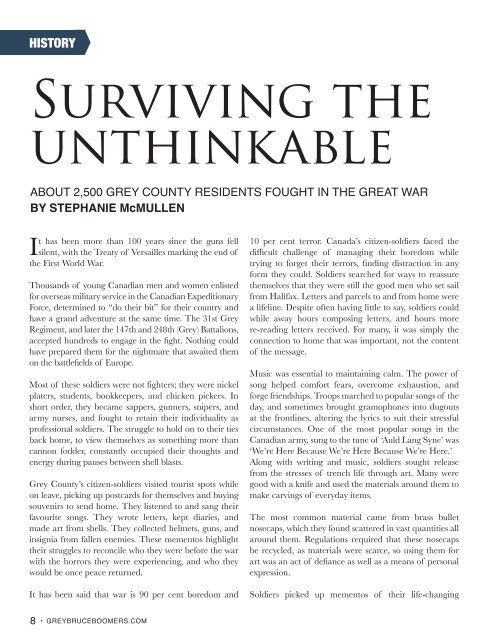Grey Bruce Boomers Fall 2021
You also want an ePaper? Increase the reach of your titles
YUMPU automatically turns print PDFs into web optimized ePapers that Google loves.
HISTORY<br />
Surviving the<br />
unthinkable<br />
ABOUT 2,500 GREY COUNTY RESIDENTS FOUGHT IN THE GREAT WAR<br />
BY STEPHANIE McMULLEN<br />
It has been more than 100 years since the guns fell<br />
silent, with the Treaty of Versailles marking the end of<br />
the First World War.<br />
Thousands of young Canadian men and women enlisted<br />
for overseas military service in the Canadian Expeditionary<br />
Force, determined to “do their bit” for their country and<br />
have a grand adventure at the same time. The 31st <strong>Grey</strong><br />
Regiment, and later the 147th and 248th (<strong>Grey</strong>) Battalions,<br />
accepted hundreds to engage in the fight. Nothing could<br />
have prepared them for the nightmare that awaited them<br />
on the battlefields of Europe.<br />
Most of these soldiers were not fighters; they were nickel<br />
platers, students, bookkeepers, and chicken pickers. In<br />
short order, they became sappers, gunners, snipers, and<br />
army nurses, and fought to retain their individuality as<br />
professional soldiers. The struggle to hold on to their ties<br />
back home, to view themselves as something more than<br />
cannon fodder, constantly occupied their thoughts and<br />
energy during pauses between shell blasts.<br />
<strong>Grey</strong> County’s citizen-soldiers visited tourist spots while<br />
on leave, picking up postcards for themselves and buying<br />
souvenirs to send home. They listened to and sang their<br />
favourite songs. They wrote letters, kept diaries, and<br />
made art from shells. They collected helmets, guns, and<br />
insignia from fallen enemies. These mementos highlight<br />
their struggles to reconcile who they were before the war<br />
with the horrors they were experiencing, and who they<br />
would be once peace returned.<br />
It has been said that war is 90 per cent boredom and<br />
10 per cent terror. Canada’s citizen-soldiers faced the<br />
difficult challenge of managing their boredom while<br />
trying to forget their terrors, finding distraction in any<br />
form they could. Soldiers searched for ways to reassure<br />
themselves that they were still the good men who set sail<br />
from Halifax. Letters and parcels to and from home were<br />
a lifeline. Despite often having little to say, soldiers could<br />
while away hours composing letters, and hours more<br />
re-reading letters received. For many, it was simply the<br />
connection to home that was important, not the content<br />
of the message.<br />
Music was essential to maintaining calm. The power of<br />
song helped comfort fears, overcome exhaustion, and<br />
forge friendships. Troops marched to popular songs of the<br />
day, and sometimes brought gramophones into dugouts<br />
at the frontlines, altering the lyrics to suit their stressful<br />
circumstances. One of the most popular songs in the<br />
Canadian army, sung to the tune of ‘Auld Lang Syne’ was<br />
‘We’re Here Because We’re Here Because We’re Here.’<br />
Along with writing and music, soldiers sought release<br />
from the stresses of trench life through art. Many were<br />
good with a knife and used the materials around them to<br />
make carvings of everyday items.<br />
The most common material came from brass bullet<br />
nosecaps, which they found scattered in vast quantities all<br />
around them. Regulations required that these nosecaps<br />
be recycled, as materials were scarce, so using them for<br />
art was an act of defiance as well as a means of personal<br />
expression.<br />
Soldiers picked up mementos of their life-changing<br />
8 • GREYBRUCEBOOMERS.COM

















